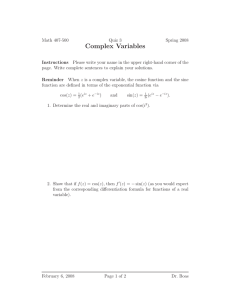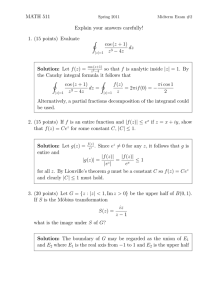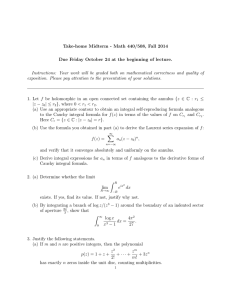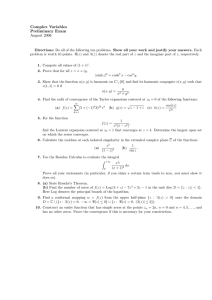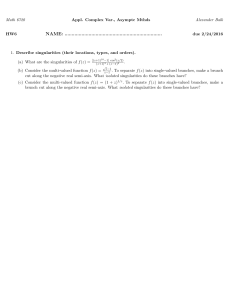MATH 440/508 - Midterm Friday, Oct 23
advertisement
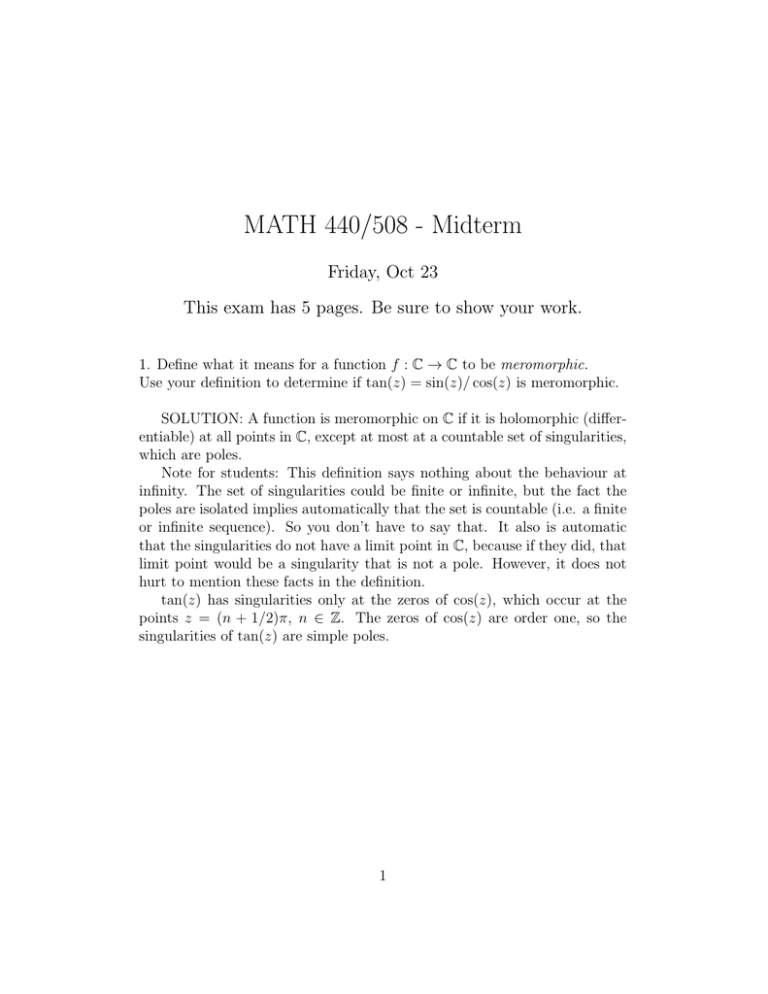
MATH 440/508 - Midterm Friday, Oct 23 This exam has 5 pages. Be sure to show your work. 1. Define what it means for a function f : C → C to be meromorphic. Use your definition to determine if tan(z) = sin(z)/ cos(z) is meromorphic. SOLUTION: A function is meromorphic on C if it is holomorphic (differentiable) at all points in C, except at most at a countable set of singularities, which are poles. Note for students: This definition says nothing about the behaviour at infinity. The set of singularities could be finite or infinite, but the fact the poles are isolated implies automatically that the set is countable (i.e. a finite or infinite sequence). So you don’t have to say that. It also is automatic that the singularities do not have a limit point in C, because if they did, that limit point would be a singularity that is not a pole. However, it does not hurt to mention these facts in the definition. tan(z) has singularities only at the zeros of cos(z), which occur at the points z = (n + 1/2)π, n ∈ Z. The zeros of cos(z) are order one, so the singularities of tan(z) are simple poles. 1 2. Compute these three integrals, with a (brief) justification of your answers. Z ∞ Z Z cos(x) − 1 1 ez dz dx dz 2 2 2 3 x −∞ |z|=2 (z − 1) (z + 1) |z|=2 z − 1 SOLUTION: For the first, integrate (eiz − 1)/z 2 on a semicircular region in the upper half plane. The integral along the upper circle of radius R decay like 2πRe−y /R2 , so it vanishes as R → ∞. Thus Z ∞ iz eiz − 1 e −1 dx = πiRes = πi(i) = −π. 0 z2 z2 −∞ The integral with the cosine is the real part of this, since cos(x) = Real(eix ), so we are are done. Note to students: It does not work to integrate (cos(z) − 1)/z 2 on the semicircular region, because cos(iy) = cosh(y) blows up exponentially. By the residue theorem, Z ez ez ez dz = 2πi(Res + Res ) z=−1 z=+1 2 (z − 1)(z + 1) (z − 1)(z + 1) |z|=2 z − 1 = 2πi(e/2 − e−1 /2) = πi(e − 1/e). This is just like the assignment question. The hard way to do it is to compute the two residues at z = ±1, using Cauchy integral formula for derivatives, and so on. The easy way is to notice, by Cauchy theorem, that we can replace the circle |z| = 2 with any circle |z| = R > 2 and not change the answer. Then the integral grows like 2πR/R5 , which goes to zero as R tends to infinity. So the original must be Z 1 dz = 0. 2 3 |z|=2 (z − 1) (z + 1) 2 3. Determine how many zeros there are in the disk of radius one, for the function f (z) = ez + 4z n , where n ≥ 0 is an integer. SOLUTION: Use Roche’s theorem, with F (z) = 4z n and G(z) = ez . On the unit circle, we have |F (z)| = 4|z|n = 4 and |G(z)| = ex ≤ e1 = 2.7.... Thus on the circle, |F (z)| > |G(z), so by Rouche’s theorem F + G has the same number of zeros as F , which has exactly n zeros. 3 4. Verify that the real-valued function u(x, y) = x3 − 3xy 2 is harmonic on the whole plane. Then find its harmonic conjugate. SOLUTION: The fast way is to notice that u(x, y) = Real(z 3 ) thus it is harmonic, with a conjugate v(x, y) = Imag(z 3 ) = 3x2 y − y 3 . Only a little slower is to note that u is twice continuously differentiable (since it is a polynomial), and a quick computation shows uxx = 6x, uyy = −6x. Thus we have uxx + uyy = 0 on the plane, so the function is harmonic. Use the Cuachy Rieman equations to find vx = −uy = −6xy, vy = ux = 3x2 − 3y 2 , then integrate to solve for v. 4 5. Suppose that f (z) is an entire function solving the equation f (z)2 = A + Bz + Cz 2 + Dz 3 , where A, B, C, D are complex constants. Show the only possible solutions are of the form f (z) = a + bz. SOLUTION: For large z we have |f (z)|2 ≤ M |z|3 and thus |f (z)| ≤ M |z|3/2 . By the Cauchy inequalities, we can conclude that for large R, we have the second derivative bounded R3/2 = M R−1/2 , R2 which tends to zero as R tends to infinity. Thus the second derivative is zero everywhere, so f 0 is constant and f is linear, az + b. |f (2) (z)| ≤ M Note to students: Some tried to do this by expanding the function f as a power series, computing the coefficients of f 2 and then suggesting that since all the higher terms of f 2 must be zero, that f must be a polynomial. That argument does not really work, because it is always possible to solve this equation locally: √ f (z) = A + Bz + Cz 2 + Dz 3 , away from any zeros of that cubic. So you can get nice analytic solutions, locally, and solve for coefficients. Somehow you need to invoke the fact that the required solution is entire, in order to get the desired result. For example, take A, C = 1, B, D = 0 and try√to solve f (z)2 = 1 + z 2 . Recall from calculus that the real function h(x) = 1 + x is nice and smooth near x = 0 so it has a Taylor series expansion 1 1 x2 3 x3 + + ···. h(x) = 1 + x − 2 4 2! 8 3! Recall, we compute the coefficients of the expansion by taking derivatives of (1 + x)1/2 and evaluating at x = 0, so it’s easy enough to figure out the coefficients. This is a perfectly good Taylor series, and its radius of convergence is one. Now define 1 1 z4 3 z6 f (z) = h(z 2 ) = 1 + z 2 − + + ···. 2 4 2! 8 3! 5 This defines a holomorphic function on the unit disk, again since the radius of convergence is one. But now √ (f (z))2 = ( 1 + z 2 )2 = 1 + z 2 . So in fact, I CAN find a non-trivial series expansion that solves f (z)2 = 1+z 2 . But notice, this f is NOT entire, since its radius of convergence is only 1. And the singularities at z = ±i cannot be removed. Also, if you prefer algebra, notice if we take the first few terms in the series and square it, 1 z4 2 1 1 1 z4 1 ) = 1+2 z 2 +( z 2 )2 −2 + higher order = 1+z 2 +0z 4 + higher order (1+ z 2 − 2 4 2! 2 2 4 2! so the z 4 term cancels out. If we compute higher order terms, we will see they cancel too. 6



